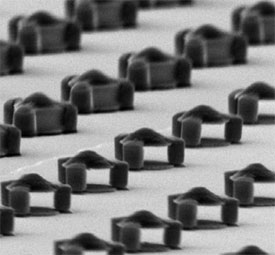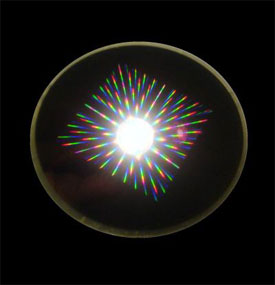BOULDER, Colo., June 20, 2008 – MRIs are coming to you live and in color. Thanks to tiny magnets that could one day be injected into the body, MRIs will be able to provide enhanced sensitivity, more information and color to a procedure that currently is imaged in black and white.
According to researchers at the National Institute of Standards and Technology (NIST) and National Institutes of Health (NIH), the new micromagnets could also act as “smart tags” that identify particular cells, tissues and physiological conditions for medical research or diagnostic purposes.
Unlike the chemical solutions that are currently being used as image-enhancing contrast agents, the NIST/NIH micro-magnets rely on a precisely tunable feature, their shape, to adjust the radio frequency (RF) signals used to create images. The RF signals then can be converted into a rainbow of optical colors by computer. Sets of different magnets designed to appear as different colors could, for example, be coated to attach to different cell types, such as cancerous versus normal. The cells then could be identified by tag color.
Microscopic magnets, designed and tested in a joint NIST/NIH project, might one day be injected into the body to add color and "smart tag" capability to magnetic resonance imaging for medical diagnosis and research.
Though these micromagnets need extensive testing, further engineering and clinical studies before they are used in people undergoing MRIs, the concept is quite flexible and could have other applications such as in enabling RF identification-based microscopic fluid devices for biotechnology and handheld medical diagnostic toolkits.
The magnets used in the NIST/NIH studies were made of nickel, which is toxic but was relatively easy to work with for the initial prototypes. According to lead author Gary Zabow, who designed and fabricated the microtags at NIST, they could be made of other magnetic materials, such as iron, which is considered non-toxic and is already approved for use in certain medical agents. Only very low concentrations of the magnets would be needed in the body to enhance MRI images.
Each micromagnet consists of two round, vertically stacked magnetic discs a few micrometers in diameter that are separated by a small open gap in between. Researchers create a customized magnetic field for each tag by making it from particular materials and tweaking the geometry, perhaps by widening the gap between the discs or changing the discs' thickness or diameter. As water in a sample flows between the discs, protons acting like twirling bar magnets within the water's hydrogen atoms generate predictable RF signals-the stronger the magnetic field, the faster the twirling-and these signals are used to create images.

The image on the right shows light scattering from grids of magnets on a wafer where they were made using conventional microfabrication techniques.
This design allows the movement or diffusion of water through the micromagnet, producing a signal that may be thousands of times stronger than that produced by a similarly sized, but stationary, volume of water. The diffusion effectively increases local MRI sensitivity, which in a future clinical setting could lead to practical benefits such as faster imaging, images that are richer with information, or reduced dose requirements for these contrast agents. The NIST/NIH test results show that changing magnet geometry results in significant shifts in the frequency signals.
MRI contrast agents enhance images by altering the magnetic field seen by hydrogen nuclei in water. Conventional contrast agents are chemically synthesized whereas the new micromagnets are microfabricated. This allows for greater control and range of the modified magnetic field, greatly enhancing sensitivity.
Furthermore, unlike the molecular chemical "soups" that make up many of the contrast agents, each micromagnet potentially could be individually detected for imaging purposes. The magnets also could be designed to be turned on and off by filling the gap between the discs to block water passage, for example. The gap could be filled with something that dissolves when exposed to certain substances or conditions, according to Zabow.
The micromagnets can be made using conventional microfabrication techniques and are compatible with standard MRI hardware. Advanced lithography techniques used to make sophisticated computer chips might be used to make the tags even smaller, even approaching the nanometer scale.
The magnets could make medical diagnostic images as information-rich as the optical images of tissue samples now common in biotechnology, which already benefits from a variety of colored markers such as fluorescent proteins and tunable quantum dots.
For more information, visit:
www.nih.gov